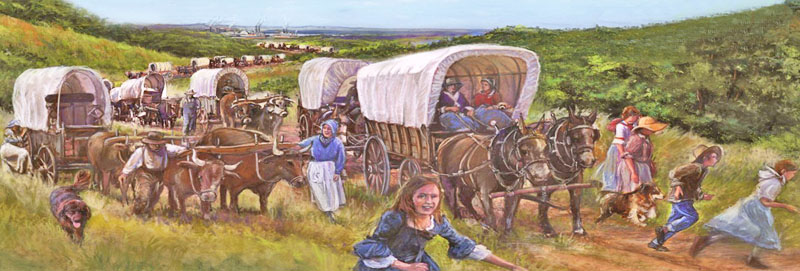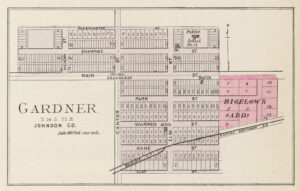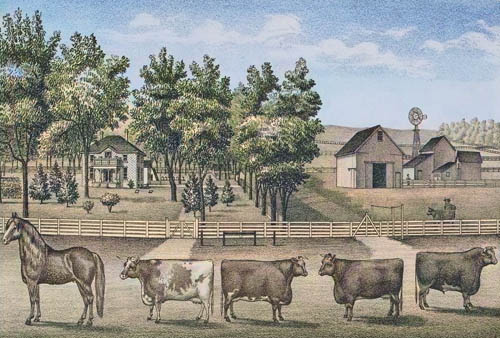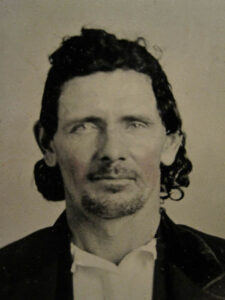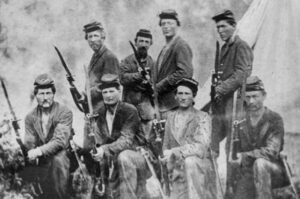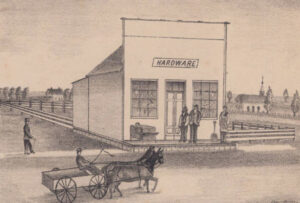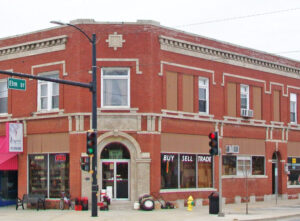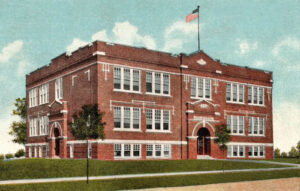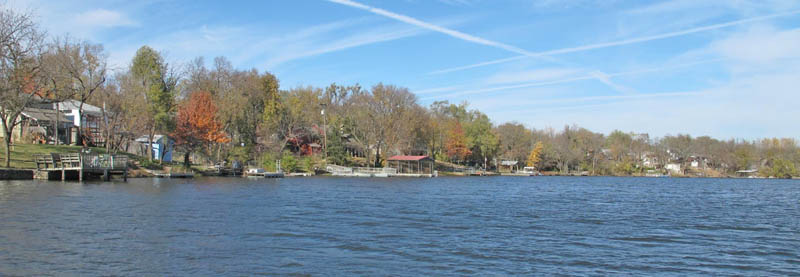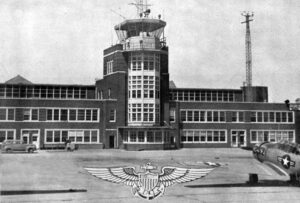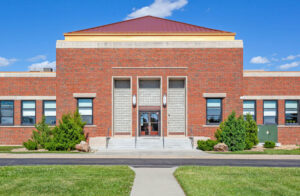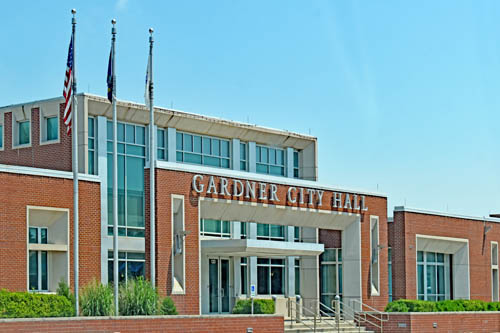Gardner, Kansas, a city in Johnson County, is located within the Kansas City metropolitan area. As of the 2020 census, its population was 23,287.
Gardner was founded where the Santa Fe Trail and the Oregon/California Trails were divided after sharing the same routes from Independence and Westport, Missouri. From the late 1820s to the mid-1860s, thousands of wagon trains heading west would arrive at this “fork in the road.” Merchant traders, fur trappers, gold seekers, and emigrants seeking a better life had two choices: they could continue southwest along the Santa Fe Trail or bear right and follow the Oregon and California trails. The Santa Fe Trail sent travelers southwest through Santa Fe and Albuquerque, New Mexico, toward Los Angeles and San Diego, California. The Oregon/California Trails bore west for a few miles before turning north toward the Kansas River Valley, followed the Big Blue River into Nebraska, followed the Platte River west, and ultimately split in present-day Wyoming, Idaho, or Utah. Whichever trail they took would be the pathway to one of the greatest adventures of their lives.
In the spring of 1857, a party consisting of Alexander R. Veach, Arthur Larrick, Ellis Miner, and W.J. Ott took up the trail from Leavenworth, Kansas, and headed southward to a region that was then being rapidly settled. On reaching Lawrence, Kansas, they fell in with a man named Fairfield, who lived on Kill Creek, about five miles northwest of where Gardner would later be founded. He told the four men about the prairies near his home that were as fine as the sun ever shown upon. The party followed Fairfield’s suggestion, reached the place on April 22, 1857, and found that its description had not been exaggerated. The greater part of Gardner Township was prairie, and the soil was extremely fertile.
Each of the four men took a quarter and started to make a home. They were the first white settlers in this neighborhood, except Fairfield, who had married a Shawnee Indian woman.
A townsite was surveyed and platted in 1857, and the town of Gardner was laid out on 320 acres in town lots in the summer of 1857. Settled primarily by emigrants from Massachusetts, it was named for Henry Gardner, then governor of Massachusetts. The town company consisted of Mr. Bartlett, president, Asa Thayer, George Chamberlin, Ben Francis and his brother, David Francis, and O.B. Gardner. The company gave a share of eight lots to anyone building a house on the townsite. W.J. Ott accepted this generous offer and built his first house on the new site of Gardner. It was not a pretentious affair made of native lumber obtained from the mill at De Soto.
The Town Company built the first house in the town. This was a frame building, measuring 14 by 20 feet, and designed for temporary purposes. Benjamin Davis kept the first hotel in a small log building, then in a frame one. The Town Company also built a hotel made of stone that year, but it was not finished until 1858. The two-story building measured 36 by 40 feet. Daniel O’Sullivan was the first blacksmith, having opened his shop in the fall of 1857. Dr. W.H. Shean arrived that and was the first physician in the town. The first church organization was the Methodists, a temporary one, in 1857. Mr. Hubert preached the first sermon in Mr. Davis’s house. E. Davis built a hotel on the Santa Fe Trail near W.J. Ott’s home. The principal attraction at his house in the way of entertainment consisted of the charm of his three daughters. The oldest married Mr. Cartright in 1857, the neighborhood’s first wedding. W.J. Ott married another in 1859.
A short time later, brothers George and Rufus Thorne came with several yokes of cattle and went into the business of breaking prairie. George Thorne settled on a claim northeast of Gardner and took a trip over the Santa Fe Trail to New Mexico the following year. His father came that fall and took Rufus Thorne’s claim. Among others who came that first year were V.R. Ellis and E. Davis.
The early settlers were nearly all Free-State men, and when the Lecompton Constitution was up for adoption in 1857, out of 103 votes cast in the township, only three were for it. Most of the settlers of nearby Olathe were pro-slavery. However, there was very little crime or law-breaking and a peaceful and neighborly set of fellows. It is true that in some parts of the country, there was a good deal of claim-jumping when men rightfully entitled to their homes were driven off by violence. A protective settlers’ association, or squatters’ association, comprised of a dozen or more community men, was established to protect the rights of actual settlers. This association had little to do and never used any violence, but it did save the homes of some of the settlers against eviction by people who had come with a view of using force. There was no shooting or hanging by this association, and its work was of the best and highest advantage to the community.
A post office in Gardner was established on March 18, 1858. In the spring of 1858, J.W. Sponable built and opened the first store in town in a long red building. Soon, S.H. Church and S.G. Sponable established the second store, and for some years, both stores in Gardner operated as wholesale and retail businesses. In the same spring, W.H. Page started a shoe shop.
The Presbyterian Church was organized that year, but a church wasn’t erected until 1870 for $3,000. Reverend Beech was the first pastor. This church was struck by lightning in August 1892 and damaged. A new church was built in 1894 for $4,000.
One of the first Free State conventions in the county was held in Gardner in 1858, and J.W. Sponable represented the township as a delegate. He was also a delegate to a convention in Olathe the same year, where a firm stand was taken against the pro-slavery party.
The first school taught was a private one by Miss Myra D. Shean. The school district was organized in the winter of 1858-59, and Miss Mary Williams taught the first public school the following summer.
A stone schoolhouse was built in 1861. At the breaking out of the Civil War in April 1861, Gardner Township had 103 voters and signalized herself by sending into the army 83 soldiers.
On October 25, 1861, the town of Garnder was sacked when Confederate guerillas led by Upton Hays and Dick Yager conducted a raid as part of the cycle of cross-border raids by the pro-Union Jayhawkers and the pro-Confederate Border Ruffians. It was the first community in Johnson County, and perhaps the first in the state, to experience an attack by Confederate forces. In this raid, 14 of the bandits were Dick Yeager’s men from Missouri, and it was reported that Cole Younger was one of the men in the band. They entered Gardner from the east, bringing a wagon and horses, probably stolen from Andrew Murphy and Henry Gorsline, two miles east of town. They also got wagons and horses from J.W. Sponable, and a third wagon and horses were taken from another party near town. The bandits arrived about 10:30 p.m.
One of the places ravaged was J.W. Sponable’s store, which was full of goods, including many fine pieces, including broadcloth, tweeds, cassimeres, silks, satins, laces, ribbons, and staple dry goods. Another store was owned by Sanford G. Sponable and L. H. Church, which was filled with clothing, dry goods, and groceries. Both stores had been thriving businesses. The bandits loaded the wagons with mostly dry goods from the counters, shelves, and drawers, dumping them in by the armfuls. Several thousand dollars worth of goods were also taken from each store. Other houses and stores in the town were not molested, no one was killed or injured, and no gun was fired.
At the time of the raid, Gardner had a few small stores, blacksmith shops, shoe shops, the Stone Hotel, the post office, about 15 to 20 dwelling houses, and about 100 residents. It also had an organized company of home militia, consisting of about 25 – 30 men recruited from various parts of the township. The State government supplied them with 16 muskets, and Osmar Green was captain. They met about once a week for drill and used a small one-story house near the center of town for their armory, where the guns and ammunition were stored between drill days.
The Gardner Library Association was organized in 1862.
On August 23, 1863, another Confederate scare by Confederate guerillas occurred in Gardner. This was on the evening when William Quantrill and his men passed through the town to sack and burn Lawrence, Kansas. They crept along, riding four abreast, with pickets out in all directions, the officers speaking to their men in a clear, deep undertone, saying: “Close up, close up.” They traded horses with a man in the town and told the man to send his bill to Leavenworth for the “boot” they were to give. They claimed new troops were going to Leavenworth to be mustered into service. However, their conduct and armament were suspicious and aroused the citizens, who hid their valuables and ran their horses and cattle to places of safety. Thankfully, no shots were fired, no houses were burned, and nothing was stolen in Gardner, but the city of Lawrence would not be so lucky.
O.B. Gardner was killed in the fall of 1864 by Jesse James when on the way to Fort Smith, Arkansas. He was Chaplain of the Thirteenth Regiment, had been North with a party of refugees, and was on his return to the regiment.
Following the Civil War, freight wagons traveling through the junction to and from Santa Fe became less common as railroad lines quickly spread across the Kansas frontier.
The Catholic Church was organized in 1870, after the railroad’s completion to this place, and their church building was erected in 1870, costing about $2,000. In 1912, a handsome new brick church was erected, measuring 35×80, costing $8,000. The first pastor was Father M.J. Casey.
The Baptist Church was organized in 1878, and its church was built in 1879 for $2,000.
In 1879, a fine two-story frame schoolhouse was built at a cost, including furniture and apparatus, of $3,000. The same year, the Baptist Church was organized, and its church was erected the same year for $2,000. Their first minister was Reverend W. A. Stewart.
Gardner was on the Kansas City, Lawrence & Southern Kansas Railroad in the early 1880s. With the building of the railroad, the Gardener began to prosper and soon became a banking, shipping, and supply point for a rich and large agricultural district.
A Grange store was opened on May 29, 1882, under the auspices of the central store at Olathe, with S. McMillan as manager. That year, Gardner had four general stores, a hardware store, two blacksmiths, an agricultural implement dealer, two drug stores, two hotels, and about 250 residents.
Gardner continued to grow through the remainder of the 19th century as routes once used by overland wagons gave way to stagecoaches, railroads, and farm equipment.
In 1910, Gardner was the third largest town in Johnson County. At that time, it was situated on the Atchison, Topeka & Santa Fe Railroad. There were several general stores, a hardware and implement house, a lumber yard, a hotel, other commercial enterprises, a money order post office, a telegraph, express facilities, and a population of 514.
The Church of Christ was built in 1912, costing $3,000.
In 1915, Gardener boasted numerous businesses including the Bigelow-Foster Merchandise Company, general merchandise; Ward & Mowrey, grain dealers; Farmers Bank, with H.C. Bigelow as cashier; Terrell & Turner, hardware; Gardner Lumber Company, building material; Cramer & Eyerly, contractors; Dodge Sisters, millinery; Gardner State Bank, with H.O. Craig, cashier; Gay Brothers, general merchandise; George B. Dent & Company, harness shop; Johnson County Telephone Company, with H.C. Bigelow as manager; J. B. Todd, creamery and ice plant; C.L. Horn, groceries and meats; Henry Young & Son, hardware; W. R. Pearce, jeweler and optician; E. E. Armstrong, drug store: R.C. Fear, physician; J.W. Stanley & Son, furniture and undertaking; J.R. Miller, barber; E.L. Eaton, editor of the Gardner Gazette; W.T. Silver, barber; Will Stern, live stock shipper; F.L. Hodges, horse dealer; H.N. Hodges,dealer in mules; P. J. Murphy, postmaster; Gardner Clothing Company, general merchandise; H.Z. Moore, dentist; A M. DeVilbiss, physician; F.N. Wilson, dentist; J.L. Smith, painter; W.H. Luther, painter; W. . Ball, shipper hay and straw; J.S. Cordell, drayman; T.H. Myers, pantitorium (shop where men could get their pants pressed;) J. C. Pack, dealer in hay, rock crusher; Laura B. Murphy, insurance and real estate; J.C.F. Ayres, real estate and insurance; L.I. Gray, garage; J.E. DeNoon Auto Supply Company, oils and auto supplies; G.J. Tobler, auto livery and feed stable; G.W. Moll, bakery; H. Clarman, blacksmith; Sam Stephens, blacksmith; James C. Shean, electric picture theatre; and E.E. Hill, restaurant.
Westminster Hall, built for public meetings, basketball, athletics, etc., was completed in 1915 for $6,000. This building measured 48 by 90 feet, had a stage, a maple floor, and was well-lighted. It had a complete kitchen and folding tables where church dinners and other social functions occurred.
By then, Gardner’s population was about 640, and its bank deposits were about $400,000. The Kansas Natural Gas Company lighted its homes and streets with natural gas. It had several strong mercantile concerns, among them the Bigelow-Foster Mercantile Company, Gay Bros., Terrell & Turner Hardware and Implement Company, Gardner Lumber Company, and all the different lines of business are well represented.
Gardner Lake, just north of the city of Gardner, was built by the Works Progress Administration between 1935 and 1938 to relieve the area’s drought conditions. In addition to the 100-acre man-made lake, tourist cabins and a beach house were constructed. This 3.5-acre recreational area is located at 30100 West 151st Street and provides area residents with fishing, swimming, boating, and picnicking today.
The Naval Air Station Olathe was built in Gardner and opened on October 1, 1942. It was referred to locally as the Gardner, Kansas, Navy Base because it was to be used for the Naval Air Transport Service and Naval Air Primary Training Command, operating out of Fairfax Airport.
Future astronaut John Glenn was in the first class to be trained at the base, and he was to make his first solo flight in a military plane from there.
“It was a sea of mud, and we made our way from building to building on wooden ‘duck boards.”
— John Glenn
After World War II, the Naval Air Reserve and Marine Air Reserve units used the Naval Air Station for flight operations, as well as a Naval Air Technical Training Center in Olathe. During the Korean War, the Olathe-based Naval Reserve Fighter Squadron 774 was recalled to active duty for two years. Its runways were lengthened in 1951 to accept the first tactical jets. By 1954, a Jet Transition Training Unit was established for propeller pilots transitioning to jet aircraft. Marine Reserve Training and Naval Reserve Training continued from 1966 until at least 1971.
For over 20 years, Naval Air Reservists and Marine Air Reservists from across the Midwest honed their skills and maintained their readiness with squadrons and support units at the Naval Air Station. However, budgetary pressures of the Vietnam War forced the air station to close. The base was decommissioned on October 29, 1969, and the air station was officially closed in July 1970 with the understanding that the Navy could retain 13 buildings for non-flying Naval Reserve aviation programs as Naval Air Reserve Center Olathe.
The airport was acquired by Johnson County in 1973 and renamed Johnson County Industrial Airport. On September 28, 1994, the name was changed to New Century AirCenter.
Gardener’s population peaked in 2020 at 23,287 and continues to grow.
Gardner is part of the USD 231 school district. Six out of the seven elementary schools are located in Gardner. The other is in Edgerton. The district also has three middle schools and the Gardner-Edgerton High School in Gardner.
According to the United States Census Bureau, the city has a total area of 10.21 square miles, of which 10.16 square miles is land and 0.05 square miles is water. The most notable body of water is Gardner Lake on the north side of town off of South Gardner Road and 151st Street. Gardner is also the genesis point of Kill Creek, which runs north, joining with the Kansas River in De Soto.
Gardener is about nine miles southwest of Olathe, Kansas, the county seat.
©Kathy Alexander/Legends of Kansas, updated February 2024.
Also See:
Santa Fe Trail in Johnson County
Sources:
Blackmar, Frank W.; Kansas: A Cyclopedia of State History, Vol I; Standard Publishing Company, Chicago, IL, 1912.
Blair, Ed; History of Johnson County, Stand Publishing Company, Lawrence, KS, 1915.
Cutler, William G; History of Kansas; A. T. Andreas, Chicago, IL, 1883.
Gardner, Kansas
Historical Marker Database
Wikipedia- Gardner
Wikipedia – Naval Air Station


